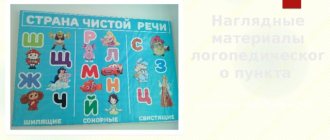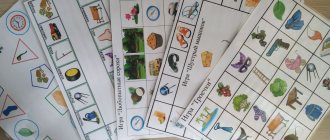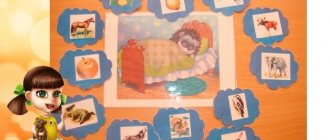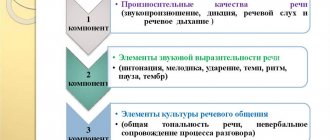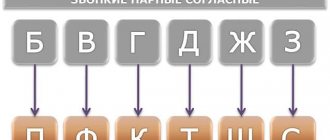Multifunctional speech therapy game “Sound snail”
Multifunctional speech therapy game
"Sonic Snail"
The manual is intended for individual and subgroup speech therapy sessions with preschool children
Target:
automation and differentiation of sounds, development of phonemic hearing, improvement of lexical and grammatical categories of speech; development of the prosodic side of speech
Tasks:
-form phonetic-phonemic representations and the syllabic structure of the word.
-develop the lexical and grammatical structure of speech, coherent speech.
-stimulate the development of mental and cognitive processes.
-maintain a positive emotional attitude.
-promote the development of children's communication and communication skills.
Annotation.
The versatility of the manual is expressed in the variety of pictures that can be used in accordance with the intended purpose. The pictures are easy to remove and attach; children can change the necessary pictures themselves.
Didactic game “The snail crawls merrily, we are lucky with pictures!”
Target:
automation of sounds in speech, strengthening the agreement of nouns with numerals in children’s speech.
Material
: pictures with images of different numbers of objects for a given sound.
Description
: an adult reads a poem:
The snail crawls slowly, swaying on a leaf,
The snail carries pictures on itself all day long!
The child names pictures, clearly pronouncing the given sounds and correctly coordinating nouns with numerals.
Didactic game “Play with the snail and name the colors!”
Target
: automation of sounds in speech, selection of nouns for adjectives denoting color, fixing the names of primary colors and shades.
Material
: pictures of multi-colored objects for a given sound.
Description
: The speech therapist asks a riddle:
The teremok, look, is crawling, carrying it on itself,
Rich mistress, horned mistress!
The snail has colorful toys in his little house! We will play with the snail and name the colors! The child names pictures, clearly pronouncing sounds, and names an adjective denoting color.
Didactic game “Let’s argue with a snail”
Target
: automation of set sounds in speech, consolidation of antonyms in the child’s dictionary.
Material
: pictures with objects indicating signs: narrow, tall, sharp, hot and others
Description
: The speech therapist reads a poem:
My motto is simple - “I carry everything with me!”
Two antennas above the gate are carried by a snail!
The child selects an adjective for the snail’s picture, and then argues with it and names another adjective with the opposite meaning.
Didactic game “Snail’s Birthday”
Goal: expanding vocabulary, learning to name the way animals call.
Material: pictures of different animals in accordance with the given sounds
Description: The speech therapist reads a poem:
The snail will have a birthday on Sunday!
The only problem is how to invite guests to your home!
Guests came to visit the snail and congratulate her on her birthday. Children name the animals and choose a word as the animal makes its voice.
Didactic game “The snail teaches the tongue to do exercises”
Target
: develop articulatory motor skills of children
Material
: pictures for articulation exercises
Description
: children look at the pictures that the snail is carrying and perform a certain articulation exercise
Speech therapy game guide “The Cheerful Snail”
Author:
Shalygina Natalya Gennadievna,
teacher speech therapist
1 category
MBDOU "Kindergarten No. 7" Nefteyugansk
The playbook “The Cheerful Snail” is intended to automate (reinforce) the sound “C” in the speech of students with sound pronunciation disorders. The manual helps to diversify children's activities during classes on mastering and consolidating the sound “C” in the child’s speech. Currently, pupils very slowly learn the whistling group of sounds, so we have to come up with additional games and play exercises using didactic and speech material familiar to children. The didactic material was selected taking into account the method of sequential assimilation of the given sound, starting with open direct and reverse syllables and words with them , for example: sa-sa-sa - sleigh, scythe, wasp; as-as-as - pineapple. Syllables can be in stressed or unstressed position. Then the sound is practiced in closed syllables and words with them, in syllables with a combination of consonants (ska-ska-ska - jump rope, mask), in phrases (baleen wasp), in sentences (A striped wasp flew into the garden) and in the spontaneous speech of the child. This the manual can be used to automate other sounds of the Russian language; it is only necessary to replace the subject pictures that are used for work, taking into account the sequence in which the child masters impaired sound pronunciation. Pupils carry out game tasks with great interest and successfully master the lesson material.
Description of the game manual.
The manual consists of subject pictures, taking into account the sequence of sound automation in the student’s speech for each studied syllable, at least 6 pictures with sound at the beginning, in the middle and at the end of the word, for example, the syllable SA - sleigh, boots, plane, scooter, wasp, fox, braid , pineapple, Karabas.
The manual also contains sheets of A-4 format, on which pictures with syllables are selected
and images of snail silhouettes.
The manual can be made from cardboard or plain paper; before working with children, all didactic material can be laminated for ease of processing and preservation.
Didactic pictures for the game manual are taken from the game N, E, Ilyakova “Sounds S, Z, C - I distinguish you”, T, S, Reznichenko, O.D, Larina Speech therapy album “Speaking correctly” - sounds S, Z, C and Internet sites - I can’t indicate the addresses since the pictures were collected a long time ago and at that time there was no need to make a link to the site.
Usage options:
Option number 1 . Automation of sound in words.
The speech therapist and pupils work on a common field with pictures, reinforcing the correct pronunciation of sounds by performing exercises: “Listen, repeat”, “Name the picture, pronouncing all the sounds correctly”, “Say it, don’t make a mistake.” At first, all exercises are performed with visual reference to pictures. Then the tasks are performed without visual support only by ear - forming the child’s auditory (phonemic) perception of the correct and clear sound of the sound.
Option number 2. Automation of sound in words using a playing field with a “Snail” silhouette.
The speech therapist and student repeat one of the exercises in option No. 1. Then the child is offered “Snail” and given tasks:
- lay out “Snail” with pictures whose names begin with the sound “S”;
- lay out “Snail” with pictures in the name of which the syllable “SA”, “CO” and others are heard as the child masters the material;
After each completed task, the child must pronounce the words he has chosen, reinforcing the correct pronunciation and, if necessary, correcting his mistakes that he made when choosing pictures.
Option #3. Develops fine motor skills, auditory and visual attention, memory.
This option teaches the child to independently carry out the proposed instructions for the correct completion of the task and self-control over the pronunciation of the sound “C” being practiced.
Tasks:
- remember and draw words with the sound “C” in any position;
- remember and draw words only with the sound “C” at the beginning of the word;
- remember and draw words with the syllable “SA”, “SU”, “STA” and so on.
After the child draws the words schematically, he must pronounce them with a clear pronunciation of the sound “C”.
Option number 4. Automation of sound in phrases and sentences in games.
- Game "One - Many"
Target. Forming the plural of a noun.
Methodical instructions. The child names and shows what he names.
- Joke game “Answer in one word”
Target. Changing a noun by case.
Task for the child: Choose one of the pictures. Answer the questions using only this word.
Questions are asked to the child taking into account cases.
A detailed description of the games can be found in the book “Speech Therapy Grammar for Kids” by O.A. Novikovskaya
- Game “Say Kindly”
Target. Learn to change nouns using diminutive suffixes (table - table).
- Game "Count"
Target. Teach your child to coordinate the endings of nouns with numerals in words and phrases. (One plane, two planes, five planes).
There were 0 votes for this work.
Voting ended on April 13, 2014 at 11:00 p.m. Thanks everyone for participating!
Share
Formation of correct sound pronunciation. Sonic snail
Soldiers Goal: automation of sound in syllables. Description of the game. Children walk in formation. When moving, they make trumpet sounds: tram-ta-ra-ra, tram-ta-ra-ra. The teacher can choose one of the children and assign him the role of a trumpet player, and the rest of the children evaluate the correctness of the sound of the trumpet (loudness, clarity).
Crows Goal: automation of the sound r in onomatopoeia and phrases. Description of the game. The teacher divides the children into three groups: the first group depicts a Christmas tree, the children stand in a circle and, lowering their hands, say: “Like crows cawing and jumping under a green Christmas tree”; the second - crows that jump in a circle and croak: kar-kar-kar... The first group of children says: “They fought over a crust, they screamed at the top of their lungs.” Second group (in a circle): kar-kar-kar... First group: “The dogs come running and the crows fly away.” A third group of children, pretending to be dogs, runs into the circle and, growling rrrr... chases the crows, which fly away to their nest (a pre-designated place). Those caught become dogs. The game is repeated until two or three of the most dexterous crows remain. Then the children change roles and continue the game.
Orchestra Goal: automation of sounds p, p' in syllables. Description of the game. Children sit in a semicircle. One group of children are trumpeters, another are violinists, and the third are drummers. The teacher is the conductor. He shows each group how to imitate the movements of trumpeters, violinists and percussionists. Then he offers to sing some familiar tune. Trumpeters sing the syllable ru-ru-ru, violinists - ri-ri-ri, and drummers - ra-ra-ra. After the rehearsal, the teacher begins to conduct. Only the group to which the teacher points with a stick sings. When the teacher raises both hands, everyone plays at the same time. Then the teacher calls three or four children and invites them to perform some song on any instrument. The rest of the children are asked to guess what song was performed.
Do you know these words? Goal: automation of sounds p, p' in syllables and words. Description of the game. The teacher pronounces the phrase without finishing the syllables in the words. Whichever child is the first to correctly pronounce the missing syllable will receive a cardboard circle. The one with the most circles wins. An approximate list of sentences: We have an ice mountain; Who's mooing? Cow); There is a fence around the park; Underground we have me(tro); There is a goalkeeper at the gate; In the morning, children do exercises; The mole has a no(ra) in the ground; Chickens go with the chickens; To write, you need tet (for the sake of); The guys lit a fire in the forest; There are lights on the streets; We love sweet va(rainier), etc.
Maintain order Goal: automation of sounds p, p' in words. Description of the game. Children sit in a semicircle. In the center there is a teacher's table, on which several objects are placed in a row, the names of which contain the sound p, p'. The teacher calls one child, who must name and show the children the objects laid out on the teacher’s table. Then the child turns his back to the table and names the objects from memory in the order in which he laid them out on the table. If the child finds it difficult to complete the task, you can allow him to carefully examine the objects again.
Then other children are called. The teacher, at his own discretion, can change the order of objects, replace them or add new ones. The following items can be selected for the game: a flashlight, a fish, a bubble, a pea, a rope, an elastic band, sugar, a rocket, a buckle, a mushroom, a mitten, etc. By repeating the game, you can give five or six items to memorize. Children should name objects loudly and clearly. (By analogy, the game can be played with other sounds.)
Do you remember these verses? Goal: automation of sounds p, p' in words. Description of the game. The teacher reads excerpts from poems familiar to the children. The child must say the missing words. Where did (sparrow) have lunch? At the zoo with (animals). Don't stand too close: I'm a tiger cub, not a pussy. In this river in the morning (early) two (sheep) drowned. Poor little camel! They don’t give food (to the child). Today he ate only two of these (buckets) since (morning). Gold letters in the sun (burn): Long live (friendship) of the Soviet (guys). All the guys from the yard shout to the painters: (Hurray)! A goat (horned) is coming for the little ones (children). Finish your milk and let's go for a walk (quickly). And the gray goat shakes his beard. Here the metro will pass through us, take everyone with it (take it).
Lamb Goal: automation of the sound r in the text, development of auditory attention. Description of the game. The driver sits on a chair with his back to the children, the others take turns approaching him and reciting rhymes. Whoever is recognized by his voice will replace the lamb, Lamb, lamb, Show me your horns, I'll give you sugar, A piece of pie! Who am I?
Rams Goal: automation of the sound r in the text. Progress of the game. Several pairs of children, standing opposite each other, holding hands, form a gate. The rest (rams) approach the gate, knock on it (stomp their feet). Rams. Tra-tra-tra, tra-tra-tra, Open the gate! Gates. Early, early, you sheep knocked on the gate. Rams. Tra-tra-tra, tra-tra-tra, Let me through the gate! Gates. Where are you going? Where are you going? We won't open the gate. Rams. To the meadows, where there is grass, And there is dew on the grass. Gates. It's too early for you to go there. We won't open the gate. Rams. Tra-tra-tra, tra-tra-tra, Goodbye, gate. We'll come when the grass dries. (They leave.)
